Athlete advocacy in professional sports plays a crucial role in addressing social issues and influencing public opinion. This article explores the motivations behind athlete activism, the effectiveness of social media platforms like Twitter and Instagram, and various forms such as charitable initiatives and public speaking. It also examines regional differences in advocacy strategies and the measurable impacts of these efforts on social change and corporate sponsorships. Lastly, the article highlights iconic figures in athlete advocacy and the risks they face while championing important causes.

What are the key motivations behind athlete advocacy in professional sports?
Athlete advocacy in professional sports is driven by several key motivations. These include raising awareness on social issues, promoting equality, and influencing policy changes. Athletes leverage their platforms to address topics such as racial injustice, mental health, and environmental sustainability. This advocacy often stems from personal experiences, a desire for community impact, and the responsibility felt towards younger generations. Furthermore, athletes aim to foster a culture of inclusivity and inspire others to engage in activism.
How do personal experiences shape athletes’ advocacy efforts?
Personal experiences significantly influence athletes’ advocacy efforts by shaping their motivations and focus areas. Athletes often draw from their own life challenges, which drives them to champion causes like mental health, social justice, and community support. For instance, those who faced adversity may advocate for similar issues, leveraging their platform to raise awareness.
Additionally, unique experiences such as injuries or personal loss can lead athletes to support specific initiatives. This connection often resonates with fans, enhancing the impact of their advocacy. Athletes like Colin Kaepernick and Serena Williams exemplify how personal narratives can amplify messages, inspiring others to engage in social change.
Furthermore, athletes’ advocacy efforts can evolve over time, reflecting their growing understanding of various issues. As they encounter new experiences, their focus may shift, leading to broader or more targeted advocacy. This dynamic nature of advocacy illustrates how personal journeys continually shape athletes’ roles as advocates in professional sports.
Why is social justice a central theme in athlete advocacy?
Social justice is central to athlete advocacy because it addresses systemic inequalities in sports and society. Athletes leverage their platforms to promote equity, inclusion, and rights for marginalized groups. High-profile cases, such as Colin Kaepernick’s protest against racial injustice, exemplify athletes’ roles in driving social change. This advocacy fosters awareness and encourages fans to engage with social issues, amplifying the impact of their messages. By prioritising social justice, athletes not only enhance their brands but also contribute to a more equitable society.
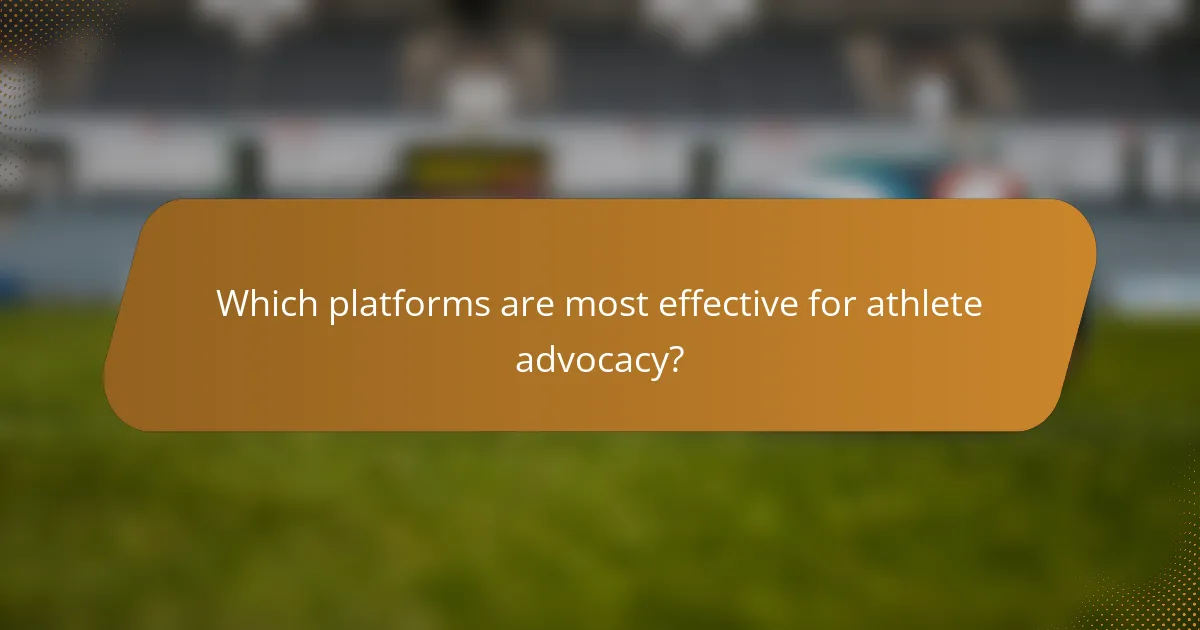
Which platforms are most effective for athlete advocacy?
Social media platforms like Twitter and Instagram are most effective for athlete advocacy. These platforms allow athletes to share their messages directly with fans and engage in conversations. Twitter’s real-time nature facilitates immediate responses, while Instagram’s visual appeal enhances storytelling. Additionally, platforms like YouTube provide a space for longer narratives and in-depth discussions. Each platform’s unique features cater to different aspects of advocacy, helping athletes amplify their voices and causes.
How do social media channels influence athlete advocacy campaigns?
Social media channels significantly amplify athlete advocacy campaigns by enhancing visibility and engagement. Platforms like Twitter and Instagram allow athletes to share personal stories, mobilise support, and raise awareness on social issues.
These channels enable real-time interaction with fans and followers, fostering community around advocacy initiatives. For instance, a campaign can gain momentum quickly through shares and retweets, reaching a wider audience than traditional media outlets.
Moreover, athletes can leverage unique attributes, such as their personal experiences and social influence, to connect authentically with their audience. This connection often leads to increased participation in campaigns and broader societal impact.
As a result, social media has transformed athlete advocacy, making it more accessible and impactful, allowing athletes to champion causes effectively.
What role do traditional media outlets play in amplifying athlete voices?
Traditional media outlets play a crucial role in amplifying athlete voices by providing platforms for expression and advocacy. They highlight issues athletes care about, such as social justice and mental health, reaching broader audiences. Through interviews and features, media can elevate these conversations, influencing public perception and policy. Additionally, traditional media serves as a bridge, connecting athletes with fans and stakeholders, fostering a community around shared values and causes. This engagement enhances the visibility of athlete-led initiatives, making their advocacy efforts more impactful.
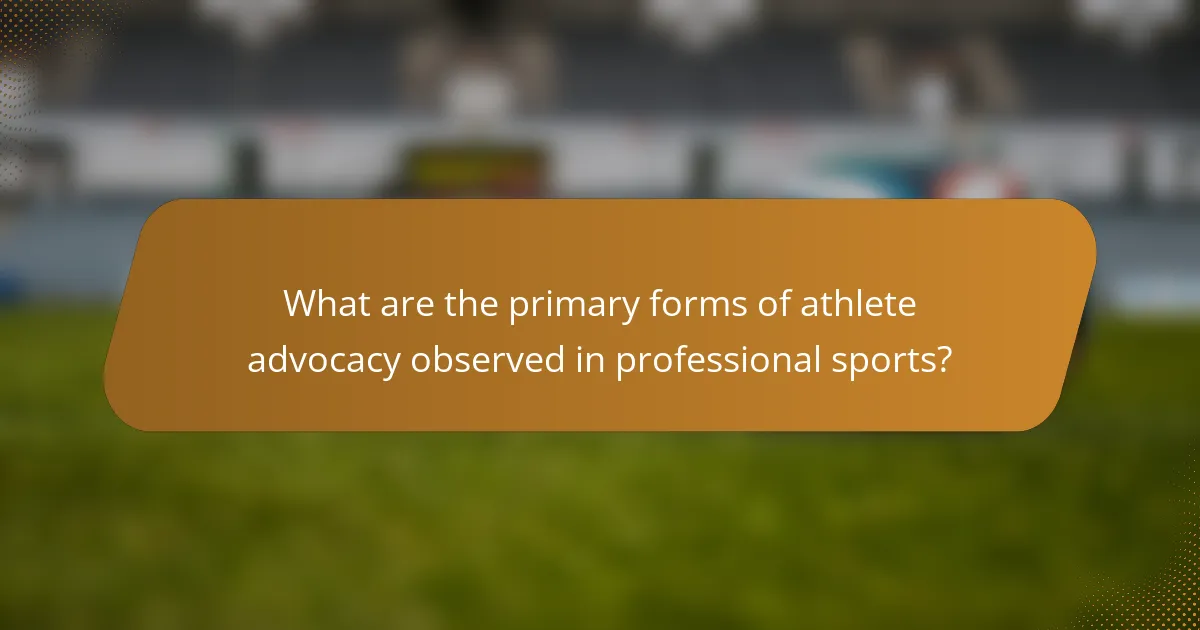
What are the primary forms of athlete advocacy observed in professional sports?
Athlete advocacy in professional sports primarily manifests through social media activism, charitable initiatives, public speaking engagements, and participation in athlete unions. These forms empower athletes to influence social change and advocate for issues like mental health, racial equality, and fair treatment. Social media activism allows athletes to reach wide audiences instantly. Charitable initiatives enable them to support communities directly. Public speaking engagements provide platforms to share personal experiences and advocate for causes. Participation in athlete unions strengthens collective bargaining power for better working conditions.
How do athletes use public speaking to promote their causes?
Athletes use public speaking to raise awareness and support for social causes. They leverage their platforms to inspire change, engage fans, and promote initiatives. By sharing personal stories, athletes connect emotionally with audiences, enhancing the impact of their advocacy. For example, many athletes address issues like mental health, racial equality, and environmental sustainability through speeches and public appearances. This approach not only amplifies their message but also mobilises communities to take action.
In what ways do athletes leverage community engagement initiatives?
Athletes leverage community engagement initiatives to foster social change and build connections. They participate in programmes that address local issues, promote health, and support youth development. Many athletes use their platforms to raise awareness about important causes, such as education and environmental sustainability. This advocacy not only benefits communities but also enhances athletes’ public images and builds fan loyalty. Engaging in these initiatives often reflects their unique values and personal experiences, creating authentic connections with their audiences.
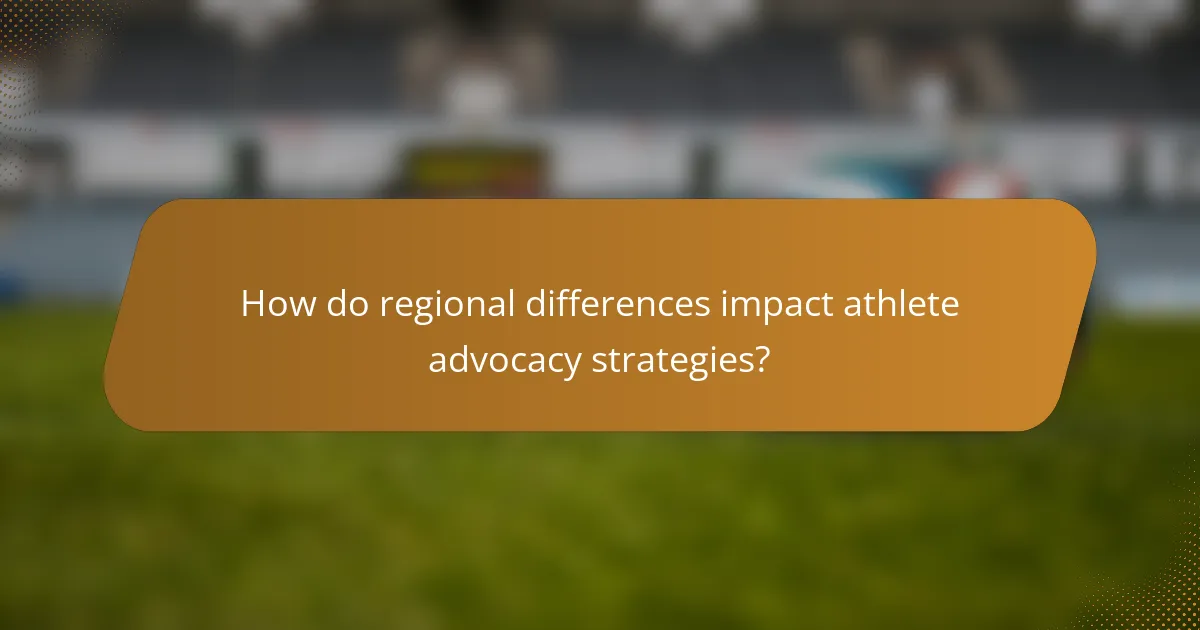
How do regional differences impact athlete advocacy strategies?
Regional differences significantly shape athlete advocacy strategies by influencing cultural perceptions, community engagement, and policy frameworks. For example, athletes in regions with strong social movements may adopt more aggressive advocacy tactics. In contrast, areas with conservative values might see athletes focusing on subtle forms of engagement, such as community service or educational initiatives.
Additionally, the level of media support and public interest varies by region, impacting the visibility of advocacy efforts. Athletes in urban areas often have greater access to platforms and resources, allowing for more extensive campaigns. In rural regions, advocacy may rely more on grassroots efforts and local partnerships, emphasising personal connections.
Moreover, the socio-economic conditions of a region can dictate the issues athletes choose to champion. In economically disadvantaged areas, advocacy may centre around basic rights and access to resources. Conversely, in wealthier regions, athletes might focus on broader social issues, such as climate change or equality.
Finally, the legal landscape can vary widely, affecting how athletes engage with advocacy. Regions with supportive legislation may encourage more outspoken activism, while those with restrictive laws might push athletes to adopt more cautious approaches.
What unique challenges do athletes face in North America compared to Europe?
Athletes in North America face unique challenges compared to their European counterparts, including differences in advocacy structures and cultural attitudes towards sports. North American athletes often contend with a more commercialised sports environment, leading to intense media scrutiny and pressure. Additionally, the lack of established player unions in some leagues can limit their collective bargaining power. In contrast, European athletes benefit from more robust advocacy networks and a greater emphasis on athlete welfare. This disparity influences how athletes navigate their careers and address issues such as mental health and contract negotiations.
How do cultural contexts shape the messaging of athlete advocacy?
Cultural contexts significantly influence athlete advocacy messaging by shaping the values and narratives presented. Different cultures prioritise various social issues, affecting how athletes communicate their messages. For instance, in the United States, athletes often focus on racial equality and social justice, while in Europe, environmental sustainability may take precedence.
Athletes adapt their advocacy strategies to resonate with local audiences, using culturally relevant symbols and language. This approach enhances engagement and fosters a deeper connection with fans. Additionally, athletes’ backgrounds inform their advocacy, as personal experiences shape their perspectives on societal issues.
Cultural contexts also dictate the reception of advocacy messages. In some cultures, athletes are seen as role models, amplifying their influence, while in others, their activism may be met with skepticism. Understanding these dynamics is crucial for effective communication in professional sports advocacy.
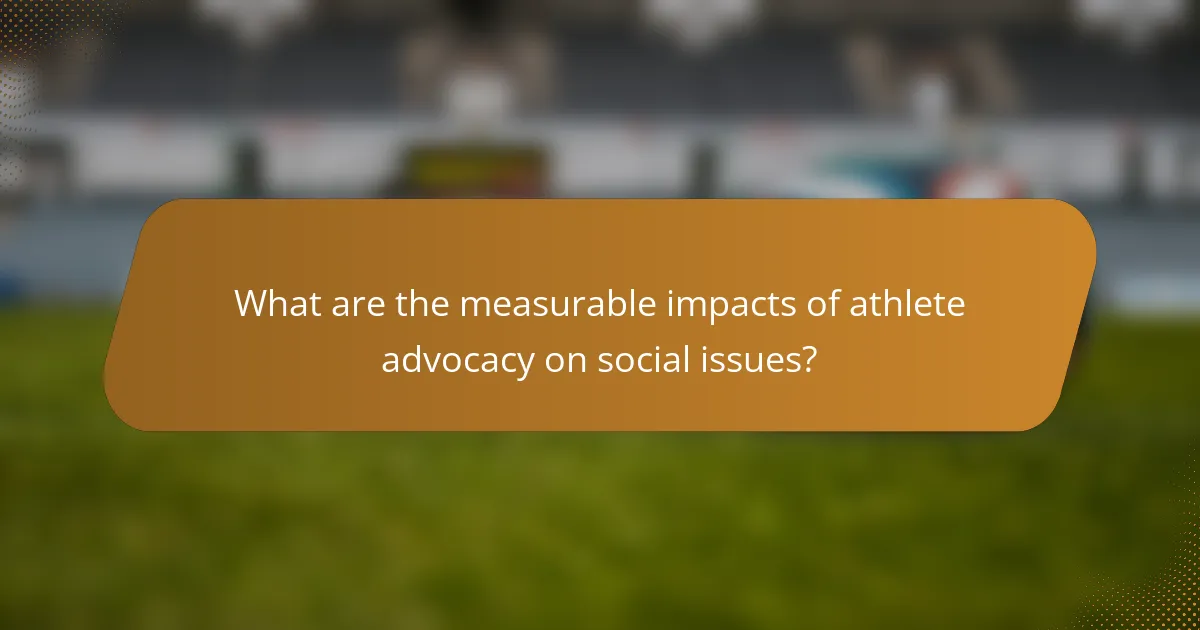
What are the measurable impacts of athlete advocacy on social issues?
Athlete advocacy significantly impacts social issues by raising awareness and influencing public opinion.
One measurable impact is increased visibility for social causes, as athletes leverage their platforms to address issues like racial injustice and mental health. For instance, athletes participating in campaigns can boost engagement by up to 50%.
Another impact is the shift in corporate sponsorships. Brands often align with athletes advocating for social change, resulting in increased funding for community initiatives. This trend shows a 30% rise in sponsorship deals linked to advocacy efforts.
Additionally, athlete-led initiatives can lead to policy changes. Advocacy efforts have prompted legislative discussions on topics such as player rights and community support, demonstrating a measurable influence on governance.
These impacts illustrate how athlete advocacy serves as a powerful tool for social change in professional sports.
How has athlete advocacy influenced public policy changes?
Athlete advocacy has significantly influenced public policy changes by raising awareness and driving social justice initiatives. Athletes use their platforms to address issues like racial inequality and mental health, leading to legislative discussions. For example, the activism surrounding police brutality has prompted policy reviews in several states. Moreover, collective athlete actions, such as strikes or unified statements, have pressured organisations to adopt more equitable practices. This advocacy not only shapes public opinion but also encourages legislative bodies to consider reforms that reflect the athletes’ messages.
What evidence exists linking athlete advocacy to changes in societal attitudes?
Athlete advocacy significantly influences societal attitudes by raising awareness and fostering dialogue on social issues. Professional athletes utilise their platforms to challenge injustices, leading to changes in public perception. For instance, campaigns led by athletes have prompted discussions on racial equality and mental health, resulting in increased support for related initiatives. Research indicates that 70% of fans are more likely to support causes championed by athletes they admire. This demonstrates the unique attribute of athletes as influential advocates in shaping cultural norms and values.
![]()
Which athletes have become iconic figures in advocacy, and why?
Athletes become iconic figures in advocacy by leveraging their platforms to address social issues. Prominent examples include Colin Kaepernick, who protested racial injustice, and Serena Williams, who advocates for gender equality in sports. Their actions inspire change and raise awareness, demonstrating the power of athlete advocacy.
Other notable figures include Muhammad Ali, known for his stance against the Vietnam War, and Billie Jean King, who fought for equal pay in tennis. These athletes use their influence to challenge societal norms and promote important causes.
Athlete advocacy often intersects with unique attributes such as personal experiences and public visibility. For instance, LeBron James combines sports with activism by addressing educational disparities through his foundation. This blend of personal commitment and professional success enhances their advocacy impact.
In recent years, the rise of social media has amplified athlete voices, allowing them to reach wider audiences. This digital platform enables athletes to engage directly with fans and advocate for issues like climate change and mental health awareness.
What unique attributes distinguish high-profile advocates from their peers?
High-profile advocates in professional sports stand out due to their extensive influence, unique platforms, and commitment to social issues. They often possess a strong personal narrative that resonates with the public, enhancing their advocacy efforts. Their ability to mobilise resources and engage diverse audiences differentiates them from their peers. Additionally, they frequently collaborate with organisations, leveraging their fame to amplify causes, which is a rare attribute among athletes.
How do personal brands enhance the effectiveness of athlete advocates?
Personal brands significantly enhance the effectiveness of athlete advocates by establishing credibility and fostering deeper connections with audiences. A strong personal brand allows athletes to convey their values and causes authentically, making their advocacy efforts more relatable and impactful. This connection often leads to increased engagement and support from fans and communities. For example, athletes like Colin Kaepernick have effectively used their personal brands to advocate for social justice, mobilising substantial public discourse and action.
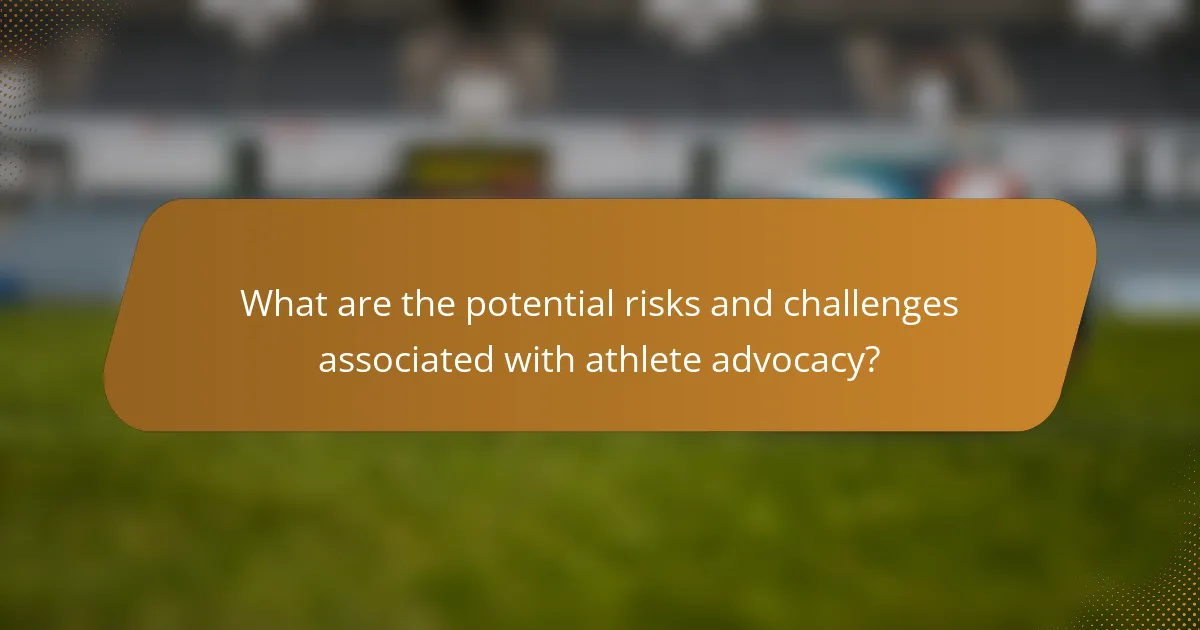
What are the potential risks and challenges associated with athlete advocacy?
Athlete advocacy carries risks, including backlash from organisations, personal attacks, and potential damage to professional relationships. Athletes may face scrutiny for their opinions, affecting sponsorship deals and fan support. Additionally, advocating for social issues can lead to isolation within their teams or leagues. Legal challenges may arise from actions taken in advocacy efforts, complicating their careers.
How can athletes navigate backlash from their advocacy efforts?
Athletes can navigate backlash from their advocacy efforts by employing strategic communication and community engagement. Building a supportive network is crucial, as it provides emotional and logistical backing.
Additionally, athletes should stay informed about the issues they advocate for, enabling them to respond effectively to criticism. Utilizing social media can amplify their message and foster direct dialogue with fans.
Furthermore, collaborating with established organisations can lend credibility to their efforts and mitigate backlash. Lastly, maintaining transparency about their motivations and experiences can help build trust with the public.
What common pitfalls should athletes avoid when engaging in advocacy?
Athletes should avoid common pitfalls like lack of research, unclear messaging, and ignoring audience engagement. These mistakes can undermine their advocacy efforts. Researching the issue ensures informed advocacy. Clear messaging helps convey the intended message effectively. Engaging with the audience fosters connection and support.
What best practices can enhance the effectiveness of athlete advocacy campaigns?
Effective athlete advocacy campaigns leverage strategic communication, collaboration, and community engagement. Utilizing social media platforms enhances visibility and fosters dialogue with fans. Partnering with organisations amplifies the reach and credibility of the message. Consistent messaging aligned with athlete values builds trust. Engaging in grassroots initiatives strengthens community ties and showcases commitment to social issues.
